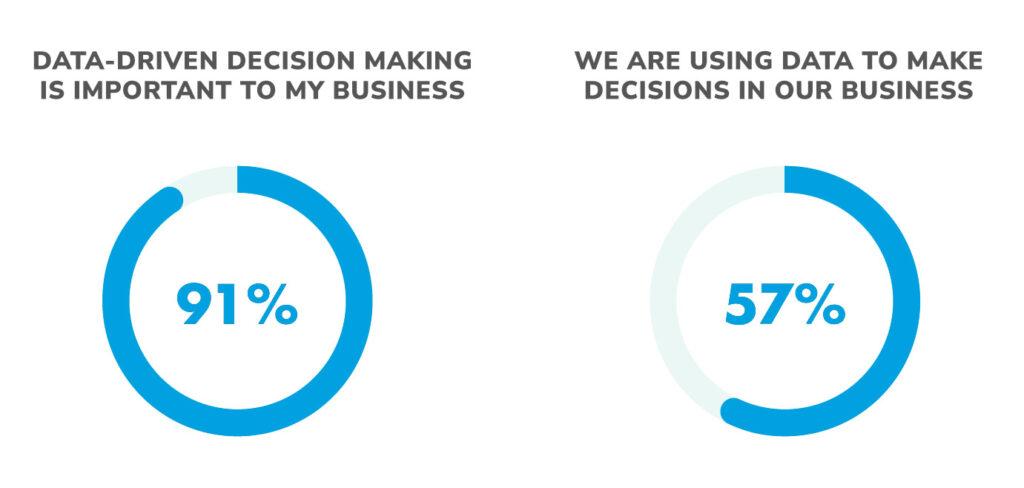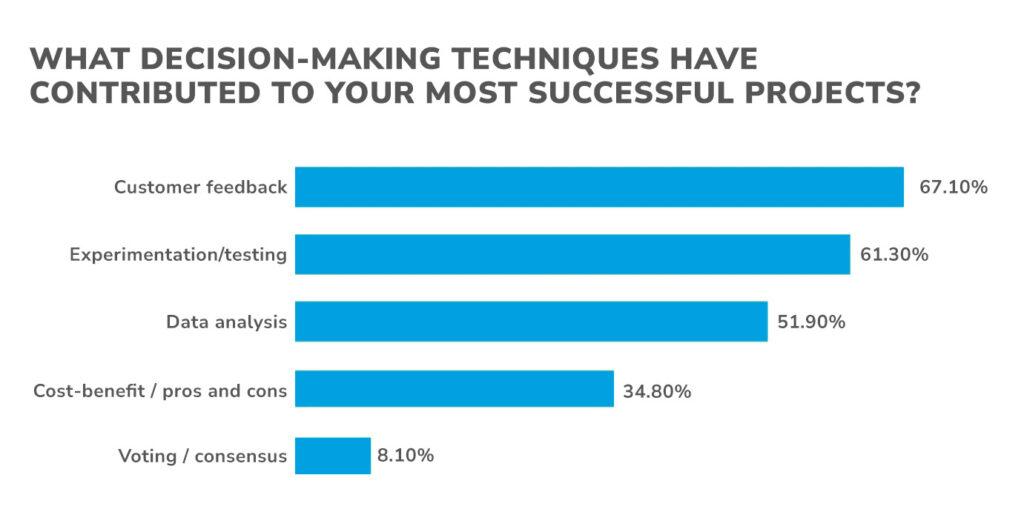Business leaders often rely on emotional intelligence skills like intuition, experience, and observation when making highly consequential business decisions. However, these methods have sometimes been found lacking in their ability to produce results, especially in rapidly changing industry landscapes and as data becomes an increasingly important part of an organization’s culture.
57% of businesses are already using data to make decisions while 91% of business leaders say that data-driven decision-making is important to their organization. This disparity between understanding the importance of using data and actively using it can be attributed to a lack of awareness about what data-driven decision-making is and how it can be achieved.

What is Data-Driven Decision-Making?
Most people can infer from the name that data-driven decision-making involves using data from multiple sources to make informed decisions at every business level. To do this effectively, businesses need to follow three steps.
- Collect relevant data from a wide variety of sources and touchpoints.
- Process the data to extract insights that are useful for decision-making.
- Present these insights in an easy-to-understand manner to decision-makers.
Once these steps are achieved, data can provide business leaders with the insight they need to confidently make informed decisions.
3 Reasons You Need to Employ Data-Driven Decision-Making Now
1. Ensure Your Teams are Working Towards a Single and Unified Goal
Business leaders set thoughtful and intentional goals and objectives. However, these goals don’t always translate into a strategic vision. This can be a result of a lack of awareness or understanding of these objectives at all levels. Finance, human resources, and other departments can sometimes operate with highly specific goals and objectives that don’t feed into the grander strategy for the business.
When attempting to conduct data-driven decision-making, businesses must put a data strategy in place that communicates the objectives of data programs and explains how each team is meant to contribute to the organization. This allows teams to better align themselves with their counterparts in other departments and better understand their role in meeting organizational goals.
2. Actively Identify and Respond to Threats and Opportunities
As business environments become more complex and competitive, decision-makers must be fully aware of the challenges and opportunities to maintain a competitive advantage in the marketplace.
The speed with which businesses can identify and respond to these challenges and opportunities can make a significant difference in whether or not they can keep pace with a rapidly evolving business environment. Businesses understand the importance of this insight, with over 67% collecting customer feedback to remain aware of how needs and preferences are changing over time.
Effective and efficient data processes can help business leaders collect and analyze data before their competitors realize that customers’ preferences or market conditions have changed. Building effective data pipelines that deliver this information to decision-makers also minimizes the time lag between identifying these opportunities and responding to them with a new strategy.

3. Optimize Operations for Maximum Output with Minimal Input
Businesses rely on highly efficient and effective processes across departments to meet their goals and objectives. However, it is not enough for each department to have processes that are optimized for their own goals. Through data collection and analysis, business leaders can find ways to better utilize the tools and assets they already have to achieve higher output. This can lead to cost savings and improved asset utilization across the business.
The Role of Data Integration in Enabling Effective Decision-Making
Data is fast becoming a critical asset for organizations worldwide. Businesses collect, store, and analyze data at unprecedented rates but this data doesn’t always generate the insight that business leaders need. Here is how data integration can help organizations make better decisions and receive more relevant insights into their operations.
Closing the Gap Among Data Silos Provides Decision-Makers with a Holistic View of Business Operations
Most businesses have had to overcome the challenges that data silos create to achieve a holistic view of their business. As specialized digital tools become more common, the information gaps created by silos can become larger.
These silos can make it difficult for business leaders to collect, consolidate, and analyze organization-wide data promptly. Data integration helps businesses create a single source of truth for every stakeholder to contribute to. This assures business leaders that they are making decisions based on the latest and most complete set of data available to them at all times.
Real-Time Data Delivery Makes Reporting Processes Less Cumbersome and More Effective
Data and insight are generated at every level of an organization and decision-makers rely on effective reporting processes to use this insight in strategy development and decision-making. Fully integrated data processes and a consolidated single source of truth can be paired with graphical interfaces and AI-powered insight generation to give business leaders a clear sense of business performance in real-time.
Collaboration Among Departments Fosters Data-Sharing Efforts
Data processes are often extremely results-oriented and are designed to deliver a certain level of insight to all who use them. Decision makers rely on consistent participation in these data processes from employees at all levels for a holistic understanding of their business. To achieve widespread buy-in for data processes, business leaders must ensure that these data sharing and management practices are not disruptive to existing workflows and can be easily understood by non-technical staff members.
Ultimately, data-driven decision-making can help organizations find new business opportunities, react to unforeseen challenges, save costs, and improve operational efficiency. However, these benefits can only be achieved when a business builds the right data foundations consistently and effectively. Data integration allows business leaders to ensure that complete, accurate, and reliable data is delivered to business leaders in real-time.
About the Guest Author
Loretta Jones is VP of Growth at Acceldata.io with extensive experience marketing to SMBs, mid-market companies, and enterprise organizations. She is a self-proclaimed ‘startup junkie’ and enjoys growing early-stage startups. She studied Psychology at Brown University and credits this major to successful marketing as well as navigating a career in Silicon Valley. She’s a nature lover and typically schedules her vacations around the migratory patterns of whales and large ocean creatures.


